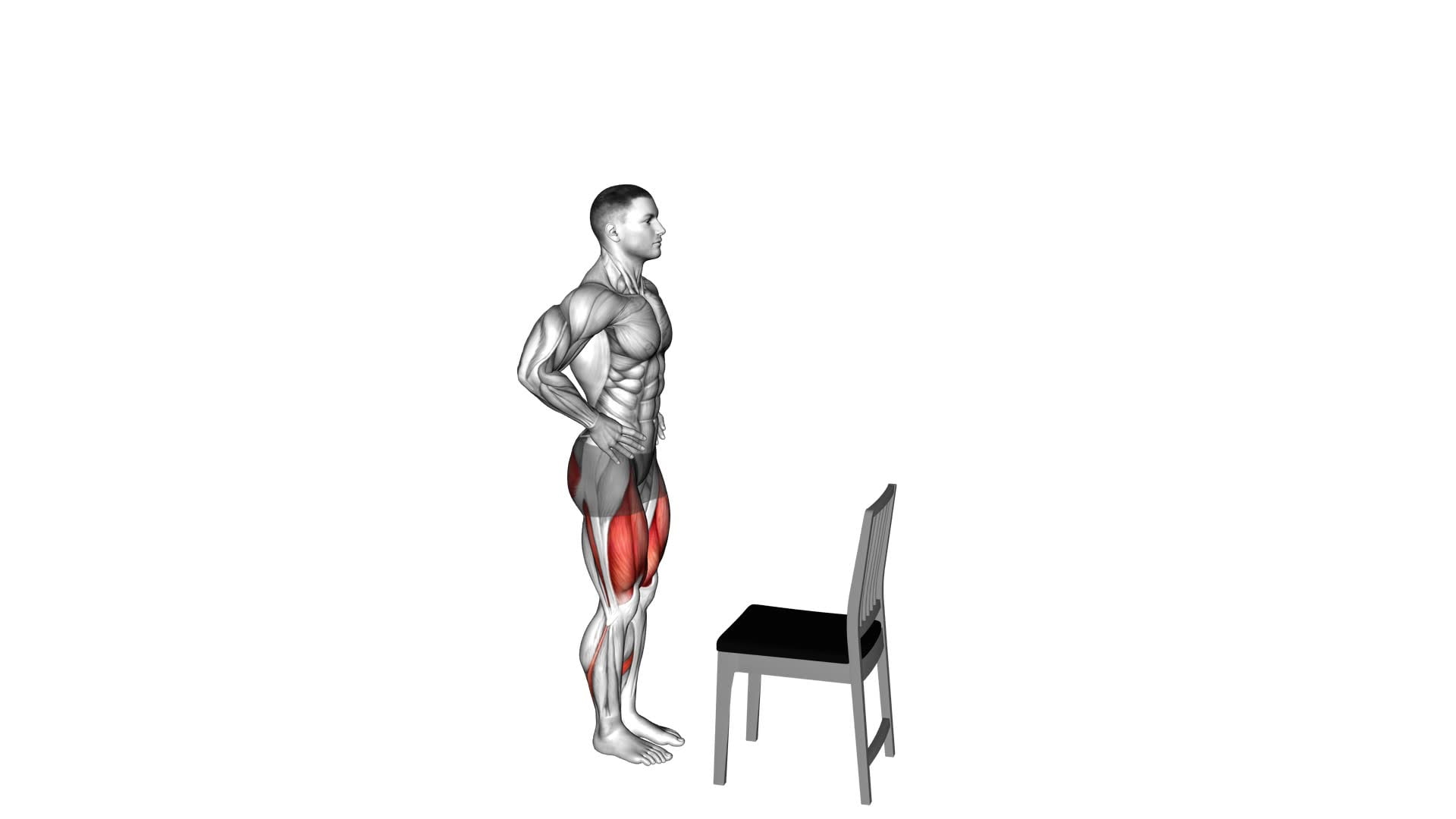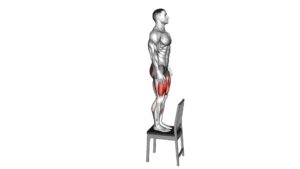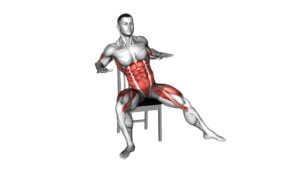Step-up on Chair (VERSION 2) – Video Exercise Guide & Tips

Are you looking for an effective and efficient way to tone your lower body? Look no further than the Step-up on Chair exercise!
Watch This Exercise Video
In this video exercise guide, we'll show you the proper form and technique to maximize your results. Avoid common mistakes and discover tips for increasing the intensity.
Plus, we'll provide modifications and progressions to suit your fitness level. Get ready to step up your workout game with this challenging exercise!
Key Takeaways
- Step-up on Chair exercise increases lower body strength.
- It engages major muscle groups in the legs.
- Step-up on Chair improves balance and coordination.
- Adding weights or increasing the height of the step can increase the intensity of the exercise.
Benefits of the Step-up on Chair Exercise
Experience increased lower body strength and improved balance by incorporating the step-up on chair exercise into your fitness routine. This exercise is highly beneficial for both muscular strength and cardiovascular endurance.
By stepping up onto a chair, you engage major muscle groups in your legs, including the quadriceps, hamstrings, and glutes. These muscles work together to lift your body weight and build strength. Additionally, the step-up on chair exercise requires coordination and balance, which helps improve your stability and overall body control.
During the exercise, your heart rate increases, leading to improved cardiovascular endurance. This means that your heart becomes more efficient at pumping blood, which benefits your overall cardiovascular health. The step-up on chair exercise provides a challenging cardiovascular workout without the need for any additional equipment.
Incorporating the step-up on chair exercise into your fitness routine can help you achieve your strength and endurance goals. By regularly performing this exercise, you'll notice increased lower body strength and improved balance.
Now that you understand the benefits, let's dive into the proper form and technique for the step-up on chair exercise.
Proper Form and Technique for Step-up on Chair
To perform the step-up on chair exercise with proper form and technique, you can follow these simple guidelines.
First, stand facing the chair with your feet hip-width apart. Place one foot firmly on the chair, ensuring that your entire foot is in contact with the surface. Keep your chest lifted and engage your core for stability.
Next, press through the heel of your planted foot and lift your body up onto the chair, fully extending your leg. As you lift, engage your glutes and thigh muscles. Slowly lower yourself back down, controlling the descent. Repeat the movement on the same leg for the desired number of repetitions before switching to the other leg.
Maintaining proper form is crucial to prevent injury and maximize the benefits of step-up variations. By performing the exercise correctly, you can improve lower body strength, increase balance and stability, and enhance overall cardiovascular fitness.
Step-up variations for beginners may include using a lower surface, such as a step or bench, to make the movement more accessible. Gradually progress to a higher surface as you become more comfortable and confident.
Remember to start with a weight that challenges you but allows for proper form. Incorporating step-up variations into your workout routine can add variety and target different muscle groups, promoting well-rounded fitness.
Common Mistakes to Avoid During Step-Up on Chair
Avoid these common mistakes when performing the step-up on chair exercise to ensure proper form and maximize your results. Proper technique is crucial not only for achieving optimal results but also for preventing injuries.
Here are three common mistakes to avoid during the step-up on chair exercise:
- Using momentum: One of the most common mistakes is using momentum to push yourself up onto the chair. This not only reduces the effectiveness of the exercise but also puts unnecessary strain on your joints. Instead, focus on using the strength of your legs to lift your body up and control the movement throughout.
- Leaning forward: Another mistake is leaning forward while stepping up onto the chair. This can put excessive pressure on your knees and lower back, increasing the risk of injury. Keep your torso upright and engage your core muscles to maintain proper alignment.
- Neglecting the supporting leg: Many people tend to forget about the leg that stays on the ground while performing the step-up on chair exercise. Make sure to fully engage the supporting leg by pressing through the heel and maintaining a stable base. This will help to distribute the load evenly and reduce the risk of imbalance and injury.
Tips for Increasing the Intensity of Step-up on Chair
To increase the intensity of your step-up on a chair exercise, there are two main tips you can follow.
First, you can add weights to challenge your muscles further. This can be done by holding dumbbells or wearing a weighted vest.
Second, you can increase the height of the step you're using, either by using a taller chair or adding risers.
These adjustments will help you push your limits and make your workout more challenging.
Adding Weight for Intensity
Increase the intensity of your step-up on chair exercise by incorporating additional weight. Adding resistance to your workout routine can challenge your muscles and help you achieve better results. Here are three tips for increasing the intensity of your step-up on chair exercise:
- Dumbbells: Hold a pair of dumbbells in your hands while performing the step-up on chair exercise. This will add extra weight and engage your upper body muscles.
- Weighted Vest: Wear a weighted vest during your workout to increase the resistance. This will intensify the exercise and make it more challenging for your lower body.
- Barbell: Place a barbell across your shoulders while performing the step-up on chair exercise. This will provide a significant amount of resistance and help you strengthen your legs and glutes even more.
By incorporating additional weight, you can take your step-up on chair exercise to the next level and maximize your gains.
Now, let's explore another way to increase the intensity of this exercise by focusing on increasing step height.
Increasing Step Height
To continue challenging your muscles and achieving better results, take your step-up on chair exercise to the next level by focusing on increasing the height of your step.
Increasing the difficulty of this exercise can be done by using a higher step or platform. By raising the height, you're increasing the demand on your leg muscles, particularly your quadriceps and glutes.
This advanced variation will require more strength and stability, engaging your core and improving your balance. Be cautious when attempting higher steps and ensure that you have mastered the proper form and technique before progressing to avoid injury.
As you become more comfortable with the increased height, you can further challenge yourself by adding weights or performing the exercise at a faster pace.
Transitioning to modifications and progressions for the step-up on chair, let's explore ways to make this exercise even more effective.
Modifications and Progressions for Step-up on Chair
Start by incorporating variations and advancements to enhance your Step-up on Chair exercise. Here are three modifications and progressions that you can try:
- Weighted Step-ups: Hold a pair of dumbbells or a kettlebell in each hand while performing the step-up. This will increase the resistance and challenge your muscles even more, helping to build strength and improve stability.
- Single-leg Step-ups: Instead of using both legs to step up onto the chair, perform the exercise with only one leg at a time. This variation places greater emphasis on each leg individually, improving balance and targeting the muscles more deeply.
- Explosive Step-ups: Add a plyometric element to the step-up exercise by explosively pushing off the chair with both feet and jumping into the air. Land softly and immediately go into the next repetition. This modification increases power and cardiovascular intensity, making the exercise more challenging and dynamic.
Remember to start with the basic step-up exercise and gradually progress to these modifications as your strength and stability improve. Always maintain proper form and listen to your body to avoid injury.
Safety Precautions for Step-up on Chair Exercise
Before attempting the step-up on chair exercise, it's crucial to focus on proper form techniques to ensure safety. This includes maintaining a neutral spine, engaging your core, and keeping your knees aligned with your toes.
In addition, injury prevention tips such as wearing proper footwear and using a stable chair or step are essential. Taking these precautions will help you perform the exercise safely and effectively.
Proper Form Techniques
You should always carefully perform the step-up on chair exercise, ensuring proper form and technique. Proper form is important because it not only maximizes the benefits of the exercise but also helps prevent injuries.
Here are some key benefits of maintaining proper form during the step-up on chair exercise:
- Increased muscle activation: By maintaining proper form, you engage the muscles in your legs, glutes, and core more effectively, leading to greater muscle activation and strength gains.
- Improved balance and stability: Proper form helps improve your balance and stability, reducing the risk of falls or accidents during the exercise.
- Reduced strain on joints: Maintaining proper form ensures that the stress is distributed evenly across your joints, reducing the risk of strain or injury.
For beginners, it's important to start with variations that suit your fitness level and gradually progress. Here are some variations for beginners:
- Lower chair height: Begin by using a lower chair or step to reduce the height and intensity of the exercise.
- Slow tempo: Perform the exercise at a slower tempo to focus on proper form and stability.
- Use support: If needed, use a wall or chair for support until you feel comfortable and confident performing the exercise without assistance.
Injury Prevention Tips
To ensure a safe and injury-free experience during the step-up on chair exercise, it's essential to take proper precautions. Injury prevention should be a top priority when engaging in any physical activity. Here are some tips to help you stay safe while performing the step-up on chair exercise.
- First, make sure the chair you're using is sturdy and stable, with a non-slip surface.
- Always warm up before starting the exercise to prepare your muscles for the workout.
- It's also crucial to maintain proper form throughout the exercise, keeping your core engaged and your back straight.
- If you have any pre-existing conditions or concerns, consult with a healthcare professional before attempting this exercise.
- Remember, modifications can be made to suit your fitness level and abilities, so listen to your body and adjust accordingly.
Equipment and Stability
Ensure the chair you use for the step-up on chair exercise is stable and provides a non-slip surface to maintain equipment and stability.
Here are some equipment options and balance and stability tips to keep in mind:
- Choose a sturdy chair: Opt for a chair that's strong and can support your weight without wobbling or tipping over. Avoid using chairs with wheels or those that are too lightweight.
- Check for a non-slip surface: Look for a chair with a textured or rubberized surface to prevent slipping during the exercise. This will help ensure your feet have a firm grip and reduce the risk of accidents.
- Maintain proper balance: Before attempting the step-up on chair exercise, make sure you have a good sense of balance. Start with a low chair and gradually increase the height as you gain confidence and stability.
By following these equipment options and balance and stability tips, you can perform the step-up on chair exercise safely and effectively.
Remember to always prioritize your safety and consult with a healthcare professional before starting any new exercise routine.
Frequently Asked Questions
How Many Calories Can You Burn by Doing the Step-Up on Chair Exercise?
You can burn a significant number of calories by doing the step-up on chair exercise. The exact number of calories burned will depend on factors such as your weight, intensity, and duration of the exercise.
This exercise is a great option for beginners as it can be easily modified to suit different fitness levels. By incorporating variations for beginners, you can gradually increase the intensity and maximize the number of calories burned.
Can the Step-Up on Chair Exercise Help Improve Balance and Stability?
Improving balance and stability is an important aspect of fitness. The step-up on chair exercise can be a great way to work on these skills. By incorporating this exercise into your routine, you can challenge your coordination and strengthen the muscles that support balance.
Additionally, there are variations of the step-up on chair exercise that can further enhance your stability training. Try adding in different heights or using weights to increase the difficulty and maximize your results.
Is It Necessary to Use a Specific Type of Chair for the Step-Up on Chair Exercise?
To perform the step-up on chair exercise, you need to focus on chair height and proper form.
The question is whether a specific type of chair is necessary for this exercise. The answer is that it depends on your comfort and safety.
Consider using a sturdy chair with a height that allows your knee to bend at a 90-degree angle. This will ensure proper form and help you achieve the best results from the exercise.
Can the Step-Up on Chair Exercise Be Modified for Individuals With Knee or Hip Problems?
Yes, the step-up on chair exercise can be modified for individuals with knee or hip problems.
There are two modified variations that you can try.
First, you can do low impact step ups, where you choose a lower step or platform to reduce the strain on your joints.
Second, you can do step ups with support, using a railing or wall for balance and stability.
These modifications will help you perform the exercise safely and comfortably.
How Often Should the Step-Up on Chair Exercise Be Performed for Optimal Results?
To achieve optimal results from the step-up on chair exercise, it's important to consider frequency. The frequency at which you perform this exercise will depend on your fitness goals and abilities.
However, for most individuals, incorporating this exercise into your routine 2-3 times per week can lead to improved balance and stability, increased calorie burn, and overall strength gains.
Conclusion
In conclusion, the step-up on chair exercise is a highly effective way to strengthen your lower body muscles and improve balance. By maintaining proper form and technique, you can avoid common mistakes and maximize the benefits of this exercise.
To increase the intensity, consider adding weights or increasing the height of the chair. Additionally, modifications and progressions can be made to cater to different fitness levels.
Remember to prioritize safety and consult a professional if needed.

Author
Years ago, the spark of my life’s passion ignited in my mind the moment I stepped into the local gym for the first time. The inaugural bead of perspiration, the initial endeavor, the very first surge of endorphins, and a sense of pride that washed over me post-workout marked the beginning of my deep-seated interest in strength sports, fitness, and sports nutrition. This very curiosity blossomed rapidly into a profound fascination, propelling me to earn a Master’s degree in Physical Education from the Academy of Physical Education in Krakow, followed by a Sports Manager diploma from the Jagiellonian University. My journey of growth led me to gain more specialized qualifications, such as being a certified personal trainer with a focus on sports dietetics, a lifeguard, and an instructor for wellness and corrective gymnastics. Theoretical knowledge paired seamlessly with practical experience, reinforcing my belief that the transformation of individuals under my guidance was also a reflection of my personal growth. This belief holds true even today. Each day, I strive to push the boundaries and explore new realms. These realms gently elevate me to greater heights. The unique combination of passion for my field and the continuous quest for growth fuels my drive to break new ground.







